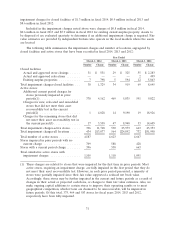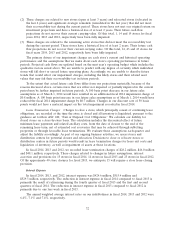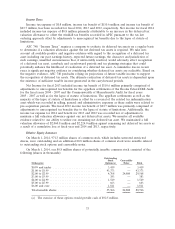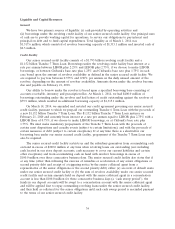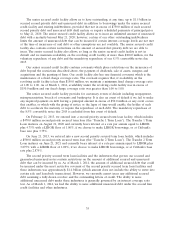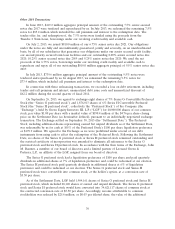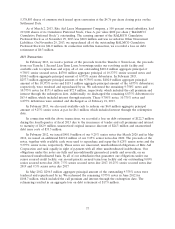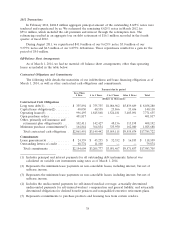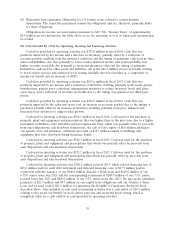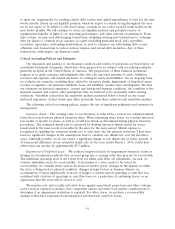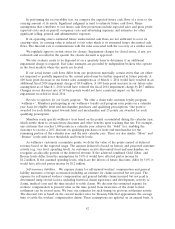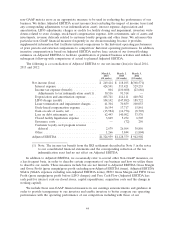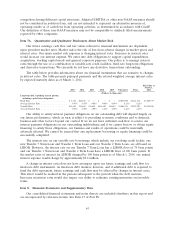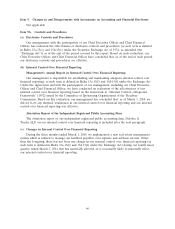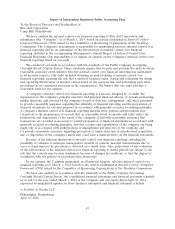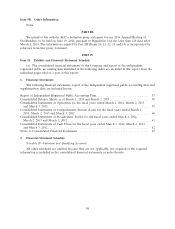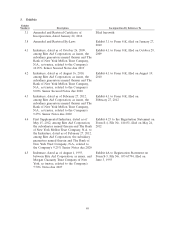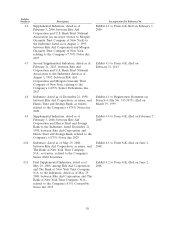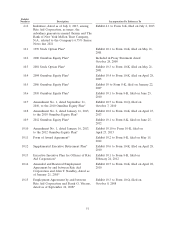Rite Aid 2014 Annual Report Download - page 42
Download and view the complete annual report
Please find page 42 of the 2014 Rite Aid annual report below. You can navigate through the pages in the report by either clicking on the pages listed below, or by using the keyword search tool below to find specific information within the annual report.to meet our requirements for working capital, debt service and capital expenditures at least for the next
twelve months. Based on our liquidity position, which we expect to remain strong throughout the year,
we do not expect to be subject to the fixed charge covenant in our senior secured credit facility in the
next twelve months. We will continue to assess our liquidity position and potential sources of
supplemental liquidity in light of our operating performance, and other relevant circumstances. From
time to time, we may seek deleveraging transactions, including entering into transactions to exchange
debt for shares of common stock, issuance of equity (including preferred stock and convertible
securities), repurchase outstanding indebtedness, or seek to refinance our outstanding debt or may
otherwise seek transactions to reduce interest expense and extend debt maturities. Any of these
transactions could impact our financial results.
Critical Accounting Policies and Estimates
Our discussion and analysis of our financial condition and results of operations are based upon our
consolidated financial statements, which have been prepared in accordance with accounting principles
generally accepted in the United States of America. The preparation of these financial statements
requires us to make estimates and judgments that affect the reported amounts of assets, liabilities,
revenues and expenses and related disclosure of contingent assets and liabilities. On an on-going basis,
we evaluate our estimates, including those related to inventory shrink, impairment of long-lived assets,
revenue recognition, self insurance liabilities, lease exit liabilities, income taxes and litigation. We base
our estimates on historical experience, current and anticipated business conditions, the condition of the
financial markets and various other assumptions that are believed to be reasonable under existing
conditions. Variability reflected in the sensitivity analyses presented below is based on our recent
historical experience. Actual results may differ materially from these estimates and sensitivity analyses.
The following critical accounting policies require the use of significant judgments and estimates by
management:
Inventory shrink: The carrying value of our inventory is reduced by a reserve for estimated shrink
losses that occur between physical inventory dates. When estimating these losses, we consider historical
loss results at specific locations, as well as overall loss trends as determined during physical inventory
procedures. The estimated shrink rate is calculated by dividing historical shrink results for stores
inventoried in the most recent six months by the sales for the same period. Shrink expense is
recognized by applying the estimated shrink rate to sales since the last physical inventory. There have
been no significant changes in the assumptions used to calculate our shrink rate over the last three
years. Although possible, we do not expect a significant change to our shrink rate in future periods. A
10 basis point difference in our estimated shrink rate for the year ended March 1, 2014, would have
affected pre-tax income by approximately $9.3 million.
Impairment of long-lived assets: We evaluate long-lived assets for impairment whenever events or
changes in circumstances indicate that an asset group has a carrying value that may not be recoverable.
The individual operating store is the lowest level for which cash flows are identifiable. As such, we
evaluate individual stores for recoverability. To determine if a store needs to be tested for
recoverability, we consider items such as decreases in market prices, changes in the manner in which
the store is being used or physical condition, changes in legal factors or business climate, an
accumulation of losses significantly in excess of budget, a current period operating or cash flow loss
combined with a history of operating or cash flow losses or a projection of continuing losses, or an
expectation that the store will be closed or sold.
We monitor new and recently relocated stores against operational projections and other strategic
factors such as regional economics, new competitive entries and other local market considerations to
determine if an impairment evaluation is required. For other stores, we perform a recoverability
analysis if they have experienced current-period and historical cash flow losses.
41


